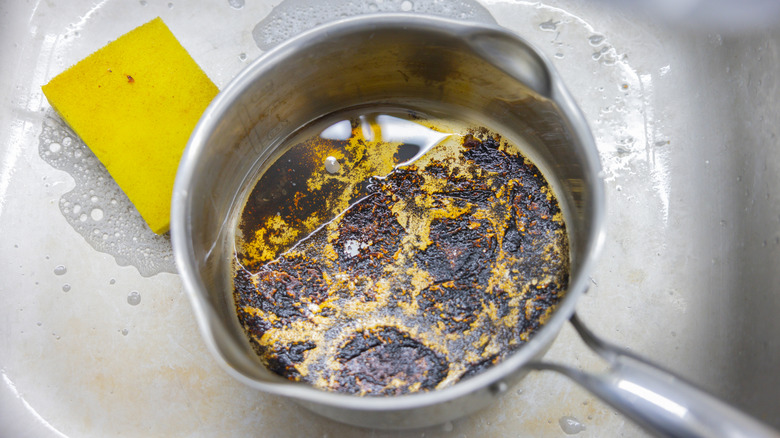How To Easily Clean Burnt Pots With The Help Of One Affordable Hack
It's annoying when pots or pans get burned, but it's also (usually) solvable. If you notice visible rust or the shape of the pot is starting to warp, it may be time to look for replacements. However, if you're dealing with burnt-on food or damage from overheating the casing on your nonstick pan, you have options. You can bring burnt pots and pans back to life with these two ingredients you probably already have in your home: hydrogen peroxide and baking soda. When used together, these staples are believed to be a secret weapon to cut through the toughest stains. That's because baking soda is a base, which when dissolved in water creates an alkaline solution. Hydrogen peroxide is acidic. When baking soda and hydrogen are combined, a chemical reaction occurs that breaks up molecules and lifts out stains.
Baking soda is non-toxic, but hydrogen peroxide should be handled carefully. Before you begin the cleaning process, wear protective clothing like gloves, because hydrogen peroxide can irritate your skin. Also check that your hydrogen peroxide is a 3% dilute, which is the solution typically sold at stores. With precautions taken, hydrogen peroxide can be an asset to your cleaning process. It's even safe to use on enameled cast iron cookware. In addition to gloves, baking soda, and hydrogen peroxide, you'll need something to scrub with such as a non-abrasive brush, sponge, or terry cloth. Now you're ready to restore your pots to their burn-free state.
Step-by-step instructions
The first step to cleaning your burnt cookware is to mix the baking soda and hydrogen peroxide together, but there are different methods to consider. One option is to create a paste by mixing the ingredients in a bowl until there is a thick paste. Then transfer the paste to the pot. Another option is to pour the hydrogen peroxide directly into the pot and sprinkle baking soda on top of it. Depending on the size of the pot, the exact amount of each ingredient that you need might differ, but a rule of thumb is 2 tablespoons of baking soda to ¼ cup of hydrogen peroxide.
Now it's time to let the mixture do its job, but there is no consensus on the duration of time to let the solution sit. It will depend on the severity of the food burn. Just be sure to monitor your pot so it is not left on too long. In some cases, you may only need to let the paste sit for 10 to 15 minutes (and a maximum of half an hour) before attacking the stains with a cloth, brush, or sponge, and then rinsing with warm water. If the stains are more severe, let the baking soda and hydrogen peroxide soak in the pot for roughly six hours before scrubbing or brushing. This should allow you to easily wipe away burns and residue. It's up to you to determine if your cookware needs another round of cleaning or needs to be replaced. Keep in mind that you should never soak your cast iron pan in water. So, be sure to take proper care when cleaning your pots and pans.

